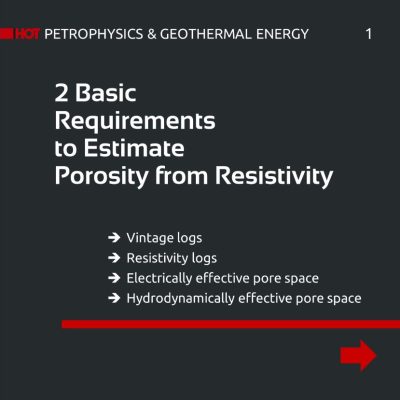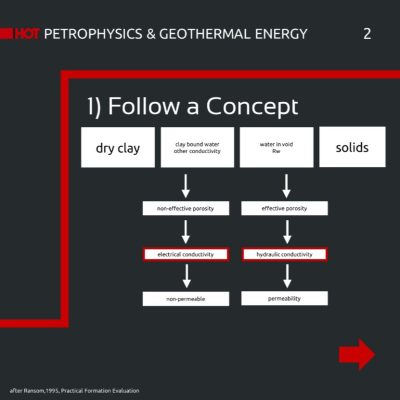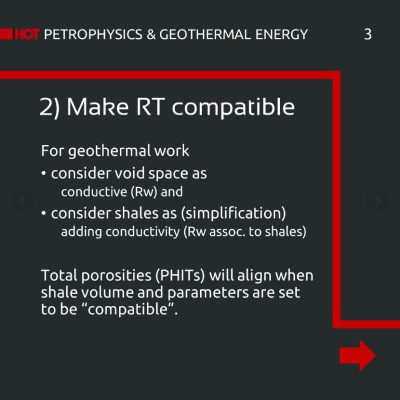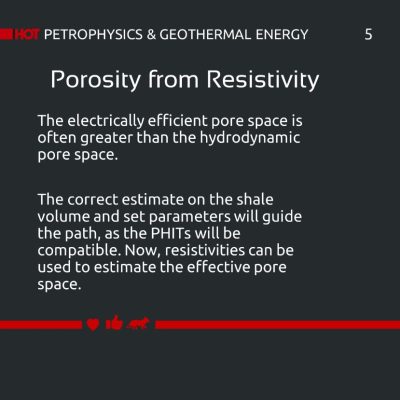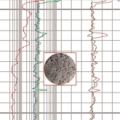Porosity from Resistivity
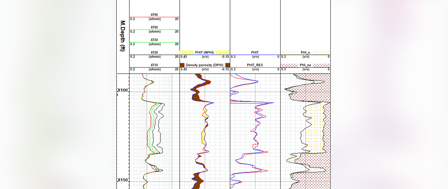
2 Basic Requirements to Estimate Porosity from Resistivity
“‘Porosity and resistivity must be compatible’ is one of the most important sentences I’ve ever read”, exclaims Dr Claudia Steiner-Luckabauer, HOT’s Principal Petrophysicist.
Especially for geothermal log interpretation, this is essential.
In water bearing zones, electrical measurements show porosity. This is good news, as ancient log suits hold preferably electrical logs rather than so-called porosity logs.
For intervals where formation water is the only conductive medium, the math is clear. But what if the resistivity is influenced from all conductive matter found next to fluids?
Then we want to separate
➡ electrically effective pore space
from
➡ hydrodynamically effective pore space, which means permeability.
We know that shaly sand interpretation needs some input from lab measurements. But what if this is not available? Especially when looking at vintage datasets for geothermal asset screening, shale parameters are not only out of reach, but they might also represent a detail difficult to implement.
Non-effective porosity is associated with clay shales, having surface conductivity and electrolytical conductivity. For geothermal work, the simple but useful combination of both gives the portion of the rock with non-effective conduction. 😊 So, this is the news: The non-effective portion of the rock gets its own electrical conductivity portion. Useful, because the resistivity logs do not know the difference anyway…The effective portion of the rock will be assigned to the formation water conductivity.
Two endpoints, a resulting varying pseudo water conductivity with shale content and associated porosity.
Rw(total) = f(Rw(effective), Rw(non-effective), shale volume). Love it.
Would you like to explore this topic in detail?
Learn about porosity, permeability, petrophysical workflows, and much more – in our course “Fundamentals in Petrophysical Log Interpretation”! Taught by the author of this article, the course lays a solid foundation for success in petrophysical endeavours.
About the Author

- Dr Claudia Steiner-Luckabauer is the Principal Petrophysicist and geothermal expert at the HOT Energy Group. She has been working in a leading role on numerous integrated reservoir characterisation and field development projects, focussing on integrated petrophysical evaluation and formation evaluation.
- As HOT’s subject matter expert, Claudia has extensive experience assessing mature oil fields, heavy oil fields, gas condensate fields, gas fields, underground gas storage, clastic and carbonate settings, low-salinity environments, unconsolidated reservoirs, and fractured reservoirs (chalk, carbonate, granite basement, sandstone). She is also an experienced instructor of academic and industry workshops on various topics in geosciences and has authored numerous papers.
HOT is your trusted partner for subsurface consulting services.
We are an experienced subsurface consultancy, supporting companies with their E&P projects as well as energy transition initiatives.
Talk with us to see how HOT can propel your subsurface project to success!

